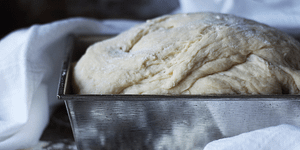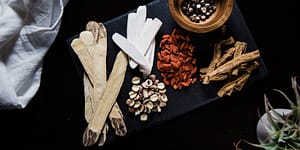Homemade Bone Broth: A Healthy Diet Staple

Looking for a soup that tastes good AND is good for you? Consider adding this nutrient-rich, immune system boosting bone broth into your daily diet!
The following is an excerpt from The Heal Your Gut Cookbook by Hilary Boynton & Mary Brackett. It has been adapted for the web.
How to Make Bone Broth
Bone broth is made from bones with a little bit of meat on them, which you cook for longer than you would a meat stock.
You can introduce bone broths into your diet once you’re through the Intro Diet and following Full GAPS.
It’s a good idea to prepare a large quantity of broth at a time; use it to make healthy soups, stews, and casseroles or simply to drink throughout the day as a beverage, complete with probiotic juice, good fat, and mineral-rich salt. What a wonder drug!
Using Bone Broth to Ease Symptoms
Occasionally, when I say to a person who is sick, “You need some homemade bone broth,” they look at me as if I’m crazy—like it’s some foreign, exotic food.
Yet this humble staple is perhaps the most traditional, nourishing, and nutrient-dense food available. It’s also dirt-cheap to make. It does take a little time and effort, but once you get the hang of it, you will be movin’ and groovin’.
Sourcing Bones for Broth
Be sure to source your bones carefully. The best bones are from 100 percent grass-fed and -finished cows, pastured chickens, and wild-caught fish.
Of course, you can make bone broth with lamb, turkey, bison, and venison bones, too. Just be sure that the livestock was raised to your standards.
The best way to ensure excellent quality is to seek out a local, sustainable farmer, or to find a reputable resource online.
Getting All the Ingredients
It took me a few years to work up the courage to order chicken feet from our co-op, and another year after that to order chicken heads. These are not ingredients we are used to seeing in the average American grocery store!
Nonetheless, they are star players in making a fine bone broth. Often people are reluctant about these ingredients, unless they grew up in a different country, in which case I sometimes hear, “Yes, that’s how we did it when I was growing up.” Or even, “We used to eat the feet right off the bone; they are so delicious!”
Even in many parts of Europe they still make use of every last animal part. It is now more important than ever for us to get back to traditional food preparation and honor the wisdom of our past. These inexpensive superfoods are a must for the GAPS Diet.
Homemade Chicken Broth
Makes about 4 quarts
When we make chicken broth we make it in one of three ways: using a whole stewing hen or layer; with the carcasses from a roasted chicken or two; or with 3 to 4 pounds of necks, backs, and wings (or a combination).
With a roasted chicken, we often save the carcass in the freezer until we have enough to make broth.
Ingredients
- 1 3- to 4-pound stewing hen, 1–2 chicken carcasses, or 3–4 pounds chicken necks, backs, and wings
- 4 quarts filtered water
- 2–4 chicken feet (optional)
- 1–2 chicken heads (optional)
- 2 tablespoons apple cider vinegar
- 3 celery stalks, coarsely chopped
- 2 carrots, coarsely chopped
- 1 onion, quartered
- Handful of fresh parsley
- Sea salt
Procedure
- Put the chicken or carcasses in a pot with 4 quarts of water; add the chicken feet and heads (if you’re using them), and the vinegar. Let sit for 30 minutes, to give the vinegar time to leach the minerals out of the bones.
- Add the vegetables and turn on the heat. Bring to a boil and skim the scum.
- Reduce to barely a simmer, cover, and cook for 6 to 24 hours.
- During the last 10 minutes of cooking, throw in a handful of fresh parsley for added flavor and minerals. Let the broth cool, strain it, and take any remaining meat off the bones to use in future cooking.
- Add sea salt to taste and drink the broth as is or store it in the fridge (up to 5 to 7 days), or freezer (up to 6 months), for use in soups and stews.
Beef Broth
Makes about 4 quarts
It’s important to include both marrow and knuckle bones so you will reap the benefits of both gelatin and marrow.
Broths can be cooked over time, so if you want to turn it off at night you can resume cooking in the morning. Just bring to a boil, skim the scum off the top, and discard.
Some people roast bones in the oven for 15 to 30 minutes before throwing them in the pot to improve the flavor of the stock, but Dr. Campbell-McBride advises using raw bones.
Ingredients
- 3–4 pounds beef marrow and knuckle bones
- 2 pounds meaty bones, such as short ribs
- 1/2 cup raw apple cider vinegar
- 4 quarts filtered water
- 3 celery stalks, halved
- 3 carrots, halved
- 3 onions, quartered
- Handful of fresh parsley
- Sea salt
Procedure
- Place the bones and remaining ingredients in a pot, add the apple cider vinegar and water, and let the mixture sit for 1 hour so the vinegar can leach the minerals out of the bones. (Add more water if needed to cover the bones.)
- Add the vegetables, bring to a boil, and skim the scum from the top and discard.
- Reduce to a low simmer, cover, and cook for 24 to 72 hours.
- During the last 10 minutes of cooking, throw in a handful of fresh parsley for added flavor and minerals. Let the broth cool and strain it, making sure all the marrow is knocked out of the marrow bones and into the broth.
- Add sea salt to taste and drink the broth as is or store it in the fridge (up to 5 to 7 days) or freezer (up to 6 months) for use in soups and stews.
Fish Broth
Serves 4 to 6
Ingredients
- 2 pounds whole fresh non-oily fish heads and bones such as cod, sole, halibut, rockfish, whiting, flounder, turbot, or snapper (heads alone make a delicious stock)
- 1/4 cup raw apple cider vinegar
- About 2 quarts filtered water
- Handful of fresh parsley
- Sea salt
Procedure
- Place the fish bones and heads in a stockpot.
- Add the vinegar and cover with water. Bring to a simmer and skim the scum.
- Simmer for 4 to 24 hours. During the last 10 minutes of cooking throw in a handful of fresh parsley for added flavor and minerals.
- Let cool and strain.
- Add salt to taste and drink the broth as is or store it in the fridge (up to 5 to 7 days) or freezer (up to 6 months) for use in soups and stew.
Bone Broths & The GAPS Diet
As the foundation of the GAPS diet, bone broths are used in the early stages to starve pathogenic bacteria in your digestive system and heal your gut.
Sealing a leaky gut can help treat disorders ranging from allergies and asthma to autism, ADD, depression, and more. However, as a healthy source of calcium, potassium, and protein, anyone looking to improve their digestive health can reap the nutritional benefits of bone broth.
Recommended Reads
Recent Articles
Want to spice up your traditional bread recipes? This salt-rising bread recipe by fermentation expert Sandor Ellix Katz has all the simplicity, flavor, and uniqueness you’ve been searching for! The following is an excerpt from Sandor Katz’s Fermentation Journeys by Sandor Ellix Katz. It has been adapted for the web. What Is Salt-Rising Bread? Salt-rising…
Read MoreLearning how to ask questions that will elicit relevant information is as much an art form as creating an herbal formula. Follow this broad list as a starting point.
Read MoreNothing says “spring” like a fresh, foraged meal! Savor the flavors of the season with this Milkweed Bud Pizza recipe.
Read MoreWhat’s so great about oyster mushrooms? First, you can add them to the list of foods that can be grown indoors! They are tasty, easy to grow, multiply fast, and they love a variety of substrates, making oyster mushrooms the premium choice. The following is an excerpt from Fresh Food from Small Spaces by R. J.…
Read More











